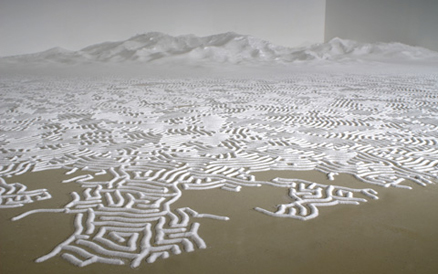03
- 03rd of Mar. 2010 -
You know how it is when a song gets stuck in your head and you just have to either hum it or hear it played to get it out? Happens to me all the time with songs from Glee - I will wake up in the morning unable to get Rain on My Parade out of my head…
As someone who remembers things visually, never by name (ask me for my favorite movie, I will tell you what it’s about but I will probably not be able to tell you what it was called), I get that with works of art that I’ve seen in the past. It happened to me this week as I was sitting at the doctor’s office and suddenly I had an image in my head of a piece I have seen in a show at the Israel Museum in Jerusalem almost 4 years ago. In my head was a very clear visual of it, though I could not for the life of me, shake me as hard as you might, remember who the artist was or what was the name of the exhibit.
The next step (which in spite of its frustrating appearance is my favorite part) was spending an hour and a half sidestepping through Google and the less-than-informative museum website, eventually finding the artist who made it. All I had to go by was my memory of this being a contemporary Japanese artist group show set a few years ago and where it was. Here are my research results:
The artist is Motoi Yamamoto, born and raised in Japan, active within the Japanese contemporary art scene. He was featured in the recent annual show at the Museum of Contemporary Art Tokyo (MOT), where he created something very similar to the piece he presented at the show in Jerusalem.
Yamamoto creates his work using salt. In Jerusalem (2006) Tokyo (2010) and many other locations in between, he used the salt to make labyrinths. Constructed of lines, these labyrinths spread out and create shapes and they stop suddenly or softly dissolve into the floor. His other salt sculptural works include complete walls, super delicate leaves, boats, stairs, and complete structures made of or filled with salt. What he does is really quite amazing, as he uses this simple mineral, so receptive to the human hand playing with it. His work is extremely delicate, painstakingly done with amazing attention to details and wonderful sensitivities of subjects.

The thing that made me remember the magnificent piece exhibited in Jerusalem is the way I physically reacted to it. In great quantities, salt can play with the air in a room. Standing close to this piece, one is mesmerized by the lines of the labyrinth and their mountain like origin. As you stand there, you can start feeling your body react to the salt - your nose burns, your eyes water. You can say that the beauty of the piece made me cry. Maybe that is why I remembered it, on a random day, in a random doctor’s office in Manhattan, NY.
So what do you think? The world wants to know!